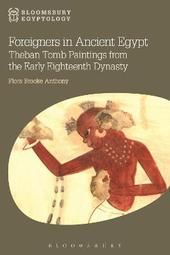
|
Foreigners in Ancient Egypt: Theban Tomb Paintings from the Early Eighteenth Dynasty
Hardback
Main Details
| Title |
Foreigners in Ancient Egypt: Theban Tomb Paintings from the Early Eighteenth Dynasty
|
| Authors and Contributors |
By (author) Dr Flora Brooke Anthony
|
| Series | Bloomsbury Egyptology |
|---|
| Physical Properties |
| Format:Hardback | | Pages:184 | | Dimensions(mm): Height 234,Width 156 |
|
| Category/Genre | African history
Egyptian archaeology and Egyptology |
|---|
| ISBN/Barcode |
9781474241588
|
| Classifications | Dewey:932.014 |
|---|
| Audience | | Undergraduate | | Postgraduate, Research & Scholarly | |
|---|
| Illustrations |
50 bw and 10 colour illus
|
|
Publishing Details |
| Publisher |
Bloomsbury Publishing PLC
|
| Imprint |
Bloomsbury Academic
|
| Publication Date |
1 December 2016 |
| Publication Country |
United Kingdom
|
Description
In ancient Egypt, one of the primary roles of the king was to maintain order and destroy chaos. Since the beginning of Egyptian history, images of foreigners were used as symbols of chaos and thus shown as captives being bound and trampled under the king's feet. The early 18th dynasty (1550-1372 BCE) was the height of international trade, diplomacy and Egyptian imperial expansion. During this time new images of foreigners bearing tribute became popular in the tombs of the necropolis at Thebes, the burial place of the Egyptian elite. This volume analyses the new presentation of foreigners in these tombs. Far from being chaotic, they are shown in an orderly fashion, carrying tribute that underscores the wealth and prestige of the tomb owner. This orderliness reflects the ability of the Egyptian state to impose order on foreign lands, but also crucially symbolises the tomb owner's ability to overcome the chaos of death and achieve a successful afterlife. Illustrated with colour plates and black-and-white images, this new volume is an important and original study of the significance of these images for the tomb owner and the functioning of the funerary cult.
Author Biography
Flora Brooke Anthony is Visiting Lecturer at Georgia State University, USA, where she teaches Art History and Egyptology. Her doctorate was from Emory University and she has received numerous awards and fellowships for her research on foreigners in ancient Egyptian paintings.
ReviewsIllustrated throughout with black-and-white and colour images, with a comprehensive bibliography, this multi-faceted analysis successfully conveys the importance of evaluating ancient Egyptian decorative motifs from several angles rather than taking them at face value. * Ancient Egypt * A reference for future research, due to the publication's strong empirical basis. * Journal of Ancient Egyptian Interconnections * Flora Anthony provides a new and original way of looking at images of foreigners in 18th dynasty non-royal tombs at Thebes. Instead of trying to identify these figures as representing specific historical ethnic groups, as other scholars have done, Dr. Anthony examines them as ideological constructs designed to function within the symbolic decorative program used to enhance and make visible the significance of the tomb both for its owner and for visitors to the monument. The resulting explanation of how the images were meant to function and be understood demonstrates the effectiveness of this approach. * Gay Robins, Samuel Candler Dobbs Professor of Art History, Emory University, USA * Dr Anthony's diligent study provides a fresh analysis of depictions of foreigners in ancient Egypt. Focussing on early 18th Dynasty Theban tomb scenes, the author revisits the established interpretation of foreigners as agents of chaos, and a more nuanced picture emerges in which foreigners symbolise the lure of alterity more broadly (danger, otherness, wealth and luxury). Ultimately, the reader is invited to consider the range of meanings that these scenes held for their ancient audiences as well as the limits of their historical value. Teeming with evidence and eminently readable, this detailed and informative work employs innovative approaches and arrives at some novel results. It is a valuable contribution to the field of study. * Glenn Godenho, Senior Lecturer in Egyptology, Liverpool University, UK *
|